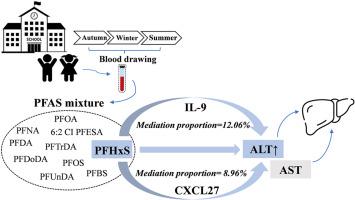全氟烷基和全氟烷基物质与儿童血清丙氨酸和天冬氨酸转氨酶水平的关系以及细胞因子的潜在介导作用
IF 7.3
2区 环境科学与生态学
Q1 ENVIRONMENTAL SCIENCES
引用次数: 0
摘要
全氟烷基和全氟烷基物质(PFAS)与儿童丙氨酸转氨酶(ALT)和天冬氨酸转氨酶(AST)相关的证据及其潜在机制尚不清楚。本研究旨在探讨PFAS与ALT和AST的关系,以及细胞因子在健康儿童中的介导作用。对中国武汉135名儿童进行了一项小组研究,对11种血浆PFAS、血清ALT和AST以及48种细胞因子进行了三次重复测量。使用线性混合效应模型、贝叶斯核机回归和加权分位数和回归来探索PFAS与ALT和AST的个体和联合关联,并使用因果中介分析来评估细胞因子在这些关联中的中介作用。研究发现,全氟十一酸(PFNA)、全氟己烷磺酸(PFHxS)、全氟十烷酸(PFUnDA)和全氟十二烷酸(PFDoDA)与ALT升高存在剂量反应关系。在两种混合暴露模型中,PFAS混合物与ALT升高相关,其中PFHxS被确定为主要因素。在超重或肥胖且每周食用鱼≥1天的儿童中,PFAS和ALT的相关性更为明显。一项综合分析揭示了一组ALT水平升高的儿童,其特征是高PFAS暴露和细胞因子水平升高。发现ccl4、CCL27、IL-2Rα、IL-9 4种细胞因子与PFNA、PFHxS、PFUnDA、ALT水平升高相关,其中CCL27和IL-9分别介导了PFHxS与ALT相关性的8.96%和12.06%。我们的研究结果表明,PFAS暴露与ALT呈正相关,CCL27和IL-9可能部分介导儿童PFAS相关的ALT升高。本文章由计算机程序翻译,如有差异,请以英文原文为准。


Associations of per- and perfluoroalkyl substances with serum alanine and aspartate aminotransferase levels and the potential mediating role of cytokines in children
Evidence on the association of per- and perfluoroalkyl substances (PFAS) with alanine aminotransferase (ALT) and aspartate aminotransferase (AST) in children, and the underlying mechanisms are still unknown. This study aims to examine the associations of PFAS with ALT and AST, and the mediating role of cytokines in healthy children. A panel study was carried out using three repeated measurements of 11 plasma PFAS, serum ALT and AST, and 48 cytokines among 134 children in Wuhan, China. Linear mixed-effect models, Bayesian kernel machine regression, and weighted quantile sum regression were used to explore the individual and combined associations of PFAS with ALT and AST. The mediating function of cytokines in these associations was assessed using causal mediation analysis. Perfluorononanoic acid (PFNA), perfluorohexane sulfonate (PFHxS), perfluoroundecanoic acid (PFUnDA), and perfluorododecanoic acid (PFDoDA) were found to have dose-response relationships with elevated ALT. PFAS mixture was associated with increased ALT in two mixed exposure models, with PFHxS identified as the major contributor. Such associations of PFAS and ALT were more evident in children who were overweight or obese and consumed fish ≥1 day/week. An integrated analysis revealed a group of children with elevated ALT levels, characterized by high PFAS exposure and increased cytokine levels. Four cytokines, including CCL 4, CCL27, IL-2Rα, and IL-9, were found to be associated with elevated levels of PFNA, PFHxS, PFUnDA, and ALT. Among them, CCL27 and IL-9 mediated 8.96 % and 12.06 % of the association of PFHxS with ALT, respectively. Our findings suggested that PFAS exposure was positively associated with ALT, and CCL27 and IL-9 might partially mediate PFAS-associated increased ALT among children.
求助全文
通过发布文献求助,成功后即可免费获取论文全文。
去求助
来源期刊

Environmental Pollution
环境科学-环境科学
CiteScore
16.00
自引率
6.70%
发文量
2082
审稿时长
2.9 months
期刊介绍:
Environmental Pollution is an international peer-reviewed journal that publishes high-quality research papers and review articles covering all aspects of environmental pollution and its impacts on ecosystems and human health.
Subject areas include, but are not limited to:
• Sources and occurrences of pollutants that are clearly defined and measured in environmental compartments, food and food-related items, and human bodies;
• Interlinks between contaminant exposure and biological, ecological, and human health effects, including those of climate change;
• Contaminants of emerging concerns (including but not limited to antibiotic resistant microorganisms or genes, microplastics/nanoplastics, electronic wastes, light, and noise) and/or their biological, ecological, or human health effects;
• Laboratory and field studies on the remediation/mitigation of environmental pollution via new techniques and with clear links to biological, ecological, or human health effects;
• Modeling of pollution processes, patterns, or trends that is of clear environmental and/or human health interest;
• New techniques that measure and examine environmental occurrences, transport, behavior, and effects of pollutants within the environment or the laboratory, provided that they can be clearly used to address problems within regional or global environmental compartments.
 求助内容:
求助内容: 应助结果提醒方式:
应助结果提醒方式:


